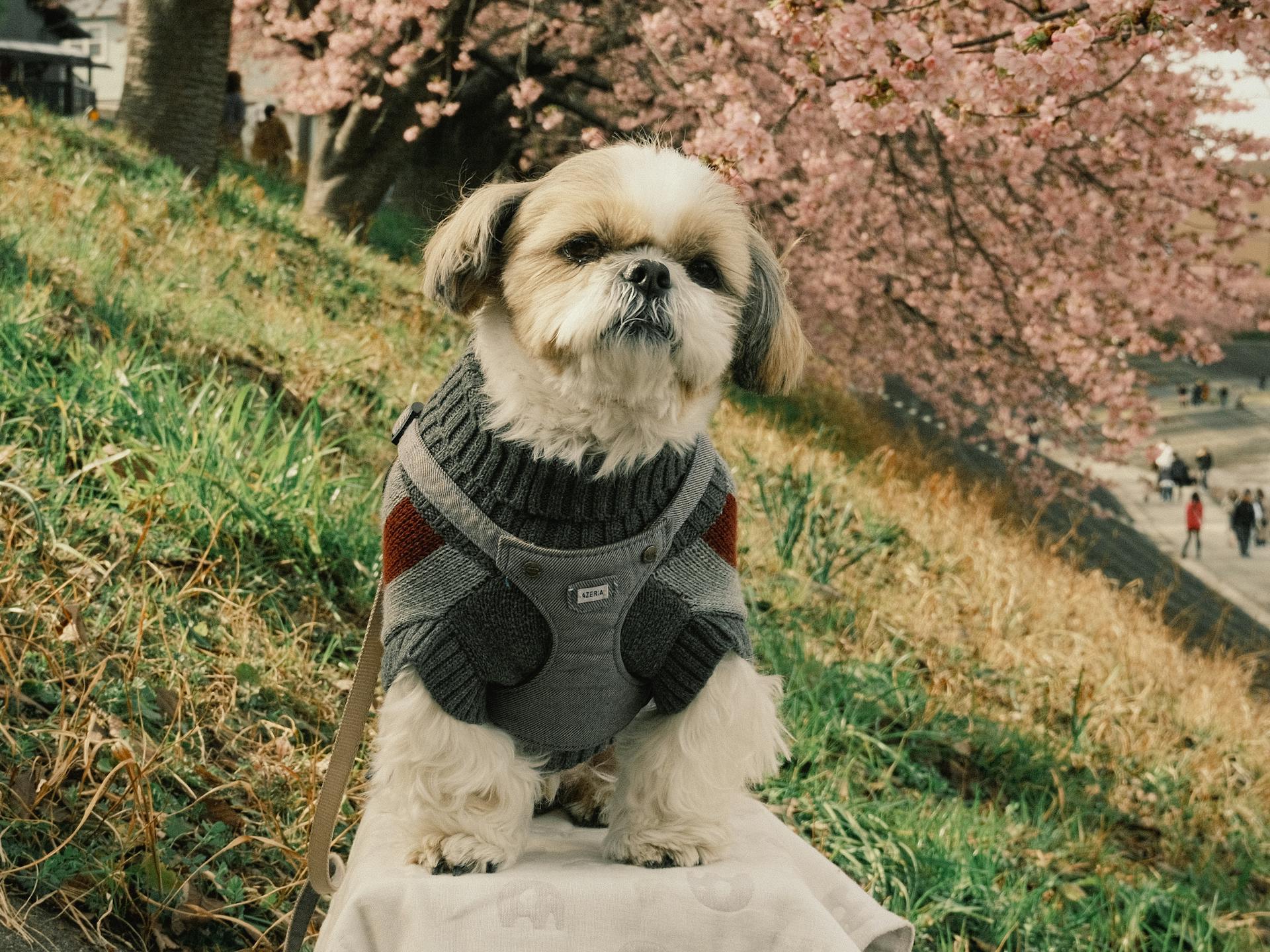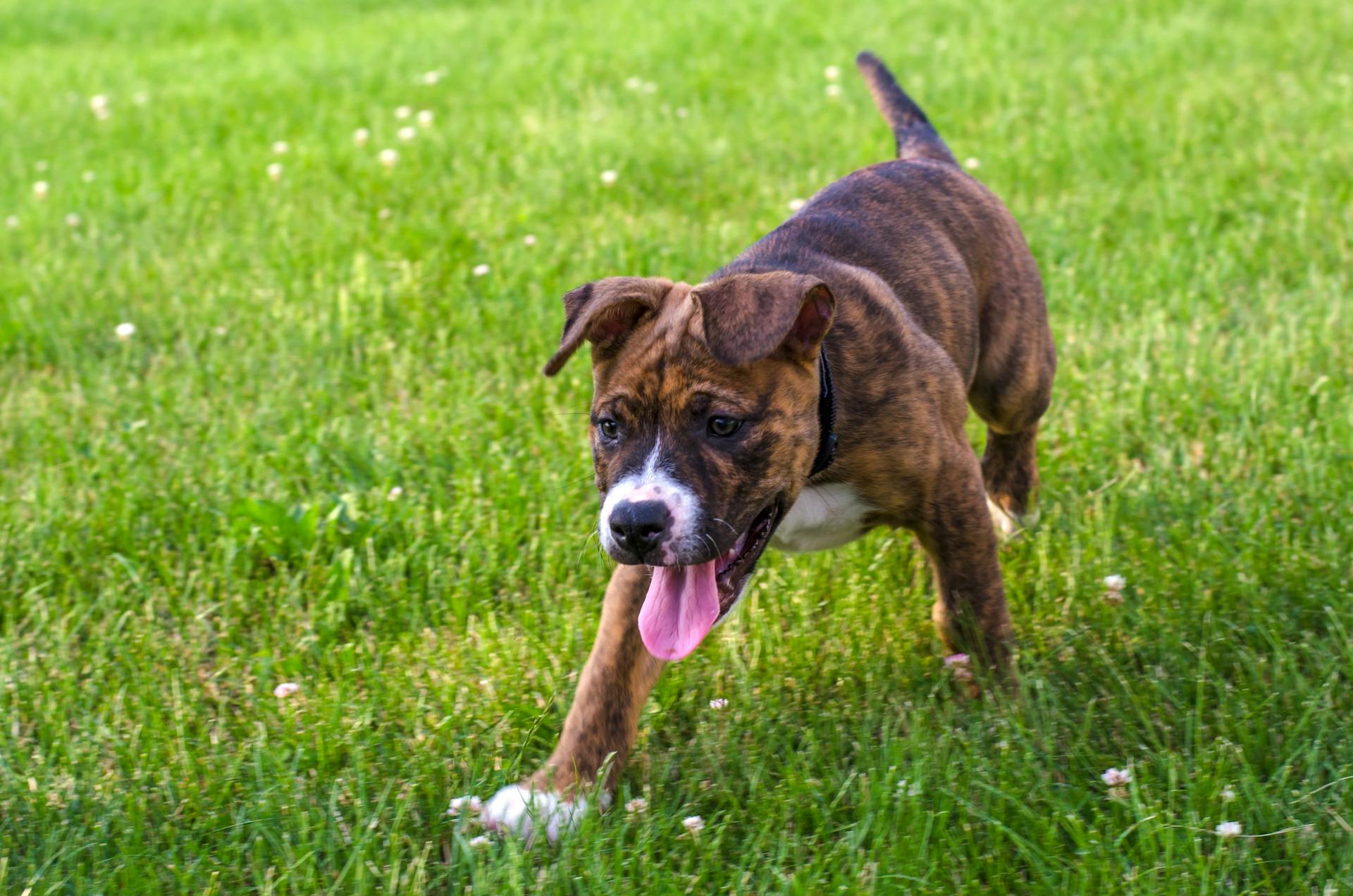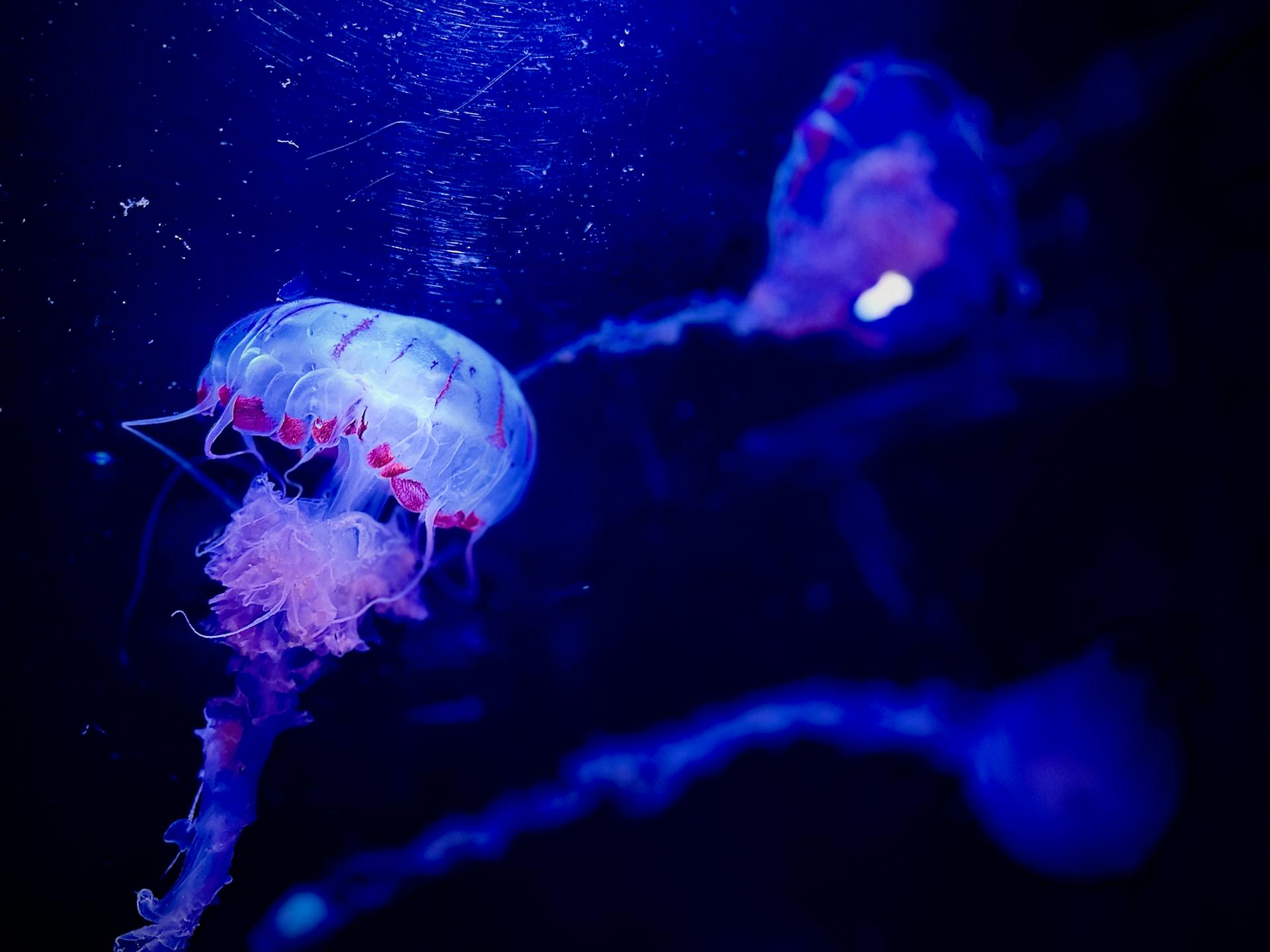
The Blue Heeler temperament is a unique blend of intelligence, energy, and loyalty.
Australian Cattle Dogs are bred to be working dogs, and as such, they have a strong instinct to herd and follow a routine.
They thrive on structure and clear communication from their owners, making them a great fit for active families or individuals who can provide regular exercise and mental stimulation.
In fact, Blue Heelers are known to be highly trainable, with a strong desire to please their owners and learn new commands.
Intriguing read: Blue Heeler Intelligence
Overview
The Blue Heeler temperament is a unique blend of intelligence, energy, and loyalty. They are highly devoted to their owner and family, often attaching themselves closely to one person and bonding less closely with others. This is often referred to as a "Velcro" dog because of their tendency to stay physically close to their chosen person.
Blue Heelers are intelligent dogs that are easy to train, but they require early and consistent socialization to help them get along with other dogs. They need to be taught how to interact with other animals and people from an early age to prevent unwanted behavior.
You might like: Red Blue Heeler Mix Dogs
One of the key characteristics of Blue Heelers is their high energy level. They require at least 2 hours of exercise daily, preferably in a fenced yard or other safe area. If they don't get enough physical and mental stimulation, they can become bored and resort to destructive behavior.
Here are some key traits of the Blue Heeler temperament:
Blue Heelers are generally friendly, but they can be wary of strangers and protective of their family and home turf. They have a strong prey drive and may view small animals as fair game. With proper training and socialization, however, they can learn to live peacefully with other pets and people.
Personality
Blue Heelers are known for their unwavering work ethic and intense devotion to their owners. They become "shadow dogs" and dislike being separated from their family.
This breed loves to be around their favorite people at all times, making it difficult to leave them alone for long periods. They're always up for a game of fetch, tug of war, or even a dip in the lake.
Blue Heelers are naturally cautious around strangers, but proper introductions can help them get along splendidly with friends and family. They might even fall in love with a new person if they offer them treats, toys, and an opportunity to play.
Their distinct blue or red coat is a trademark of the breed, but surprisingly, blue heeler puppies are born with white fur. Over their first few months of life, the coat turns blue or red, often with speckles or a mottled pattern.
Blue Heelers are highly intelligent and eager to please, making them quick to catch on to training. With positive reinforcement, they can learn manners, commands, and general dog training in no time.
Here are some key personality traits of Blue Heelers:
If a Blue Heeler doesn't get an outlet for their energy, they can become bored and destructive, chewing up shoes, furniture, or other items in the home.
Care and Needs
Blue Heelers need plenty of physical and mental stimulation to stay happy and healthy. They're not suited for apartment living or being left alone for long periods.
They require a securely fenced yard or a country farm or ranch to run around and exercise. If you can't provide that, consider canine sports to keep them active and engaged.
Early socialization and training are crucial to prevent them from becoming timid or developing bad habits like excessive chewing. Teach them to mouth only on sturdy toys, not people.
Daily activity and training will take up more time than grooming, but Blue Heelers are happy to exercise with you. They love taking up farm work as a substitute for their natural herding instinct.
If you leave them alone for too long, they might get bored and destructive, chewing up shoes or furniture. A fenced yard or safe property to run in is a must to prevent this.
Related reading: Training Blue Heeler Puppies
Blue Heelers have high prey drives, so introducing them to cats and other dogs early on is essential. If they're older, it's best to have them as the only pet.
At night, they can be outdoors in large pens with secure dens, but they'd rather be indoors with you. If you fill the day with activity, they might not care where they sleep as long as they'll get to do it with you tomorrow.
Training and Exercise
Blue Heelers are intelligent and energetic dogs that require consistent training and patience. They thrive on positive reinforcement, such as treats, praise, and playtime, to learn new skills.
To prevent boredom and destructive behavior, Blue Heelers need at least two hours of exercise a day. This can include walks, jogs, and playtime, as well as mental stimulation through puzzles and games.
With proper training and socialization, Blue Heelers can excel in canine sports like agility, flyball, and herding competitions. They're natural athletes, capable of reaching speeds of nearly 30 mph.
Curious to learn more? Check out: Are Blue Heelers Good Guard Dogs
Training
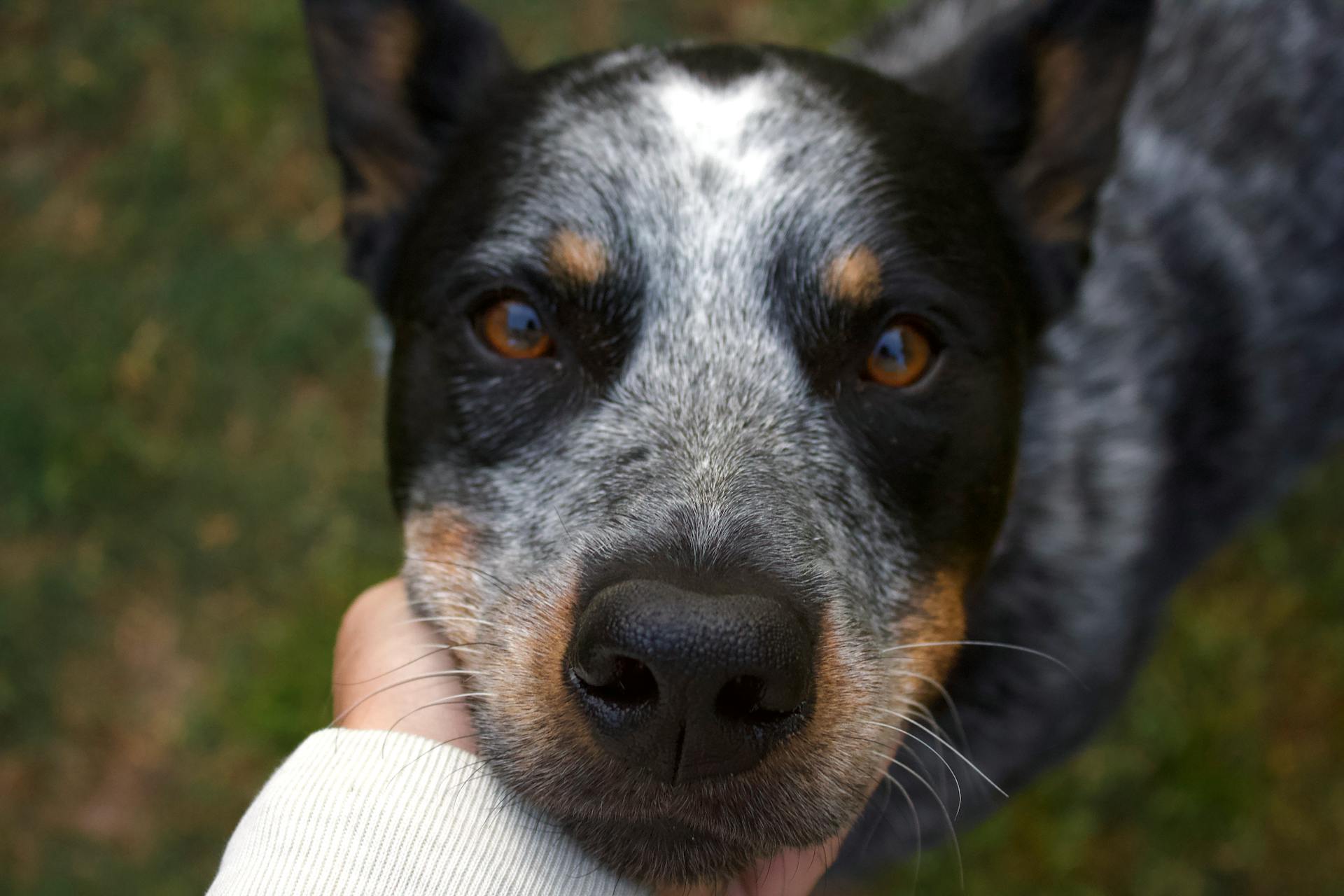
Training is a crucial aspect of Blue Heeler ownership, and it's essential to start early and be consistent. They thrive on structure and clear boundaries, so establish a routine that includes regular training sessions.
Blue Heelers are intelligent and eager to please, making them relatively easy to train with positive reinforcement. Treats, praise, and playtime are all effective rewards for good behavior.
Early socialization is vital to ensure your Blue Heeler becomes a well-adjusted adult. Expose them to new experiences, people, and environments in a safe and calm manner. This will help them develop good manners and prevent unwanted behaviors.
They have a strong herding instinct, so be prepared to teach them what is and isn't acceptable behavior around other pets and children. With patience and consistent training, you can channel their energy into a fun and rewarding activity. Blue Heelers excel in canine sports such as agility, flyball, and herding competitions.
Positive reinforcement is key to successful training, so use treats, praise, and playtime to encourage good behavior. With a bit of effort and consistency, your Blue Heeler will learn to heel, shake, and even roll over.
You might like: Blue Heeler Herding
Exercise
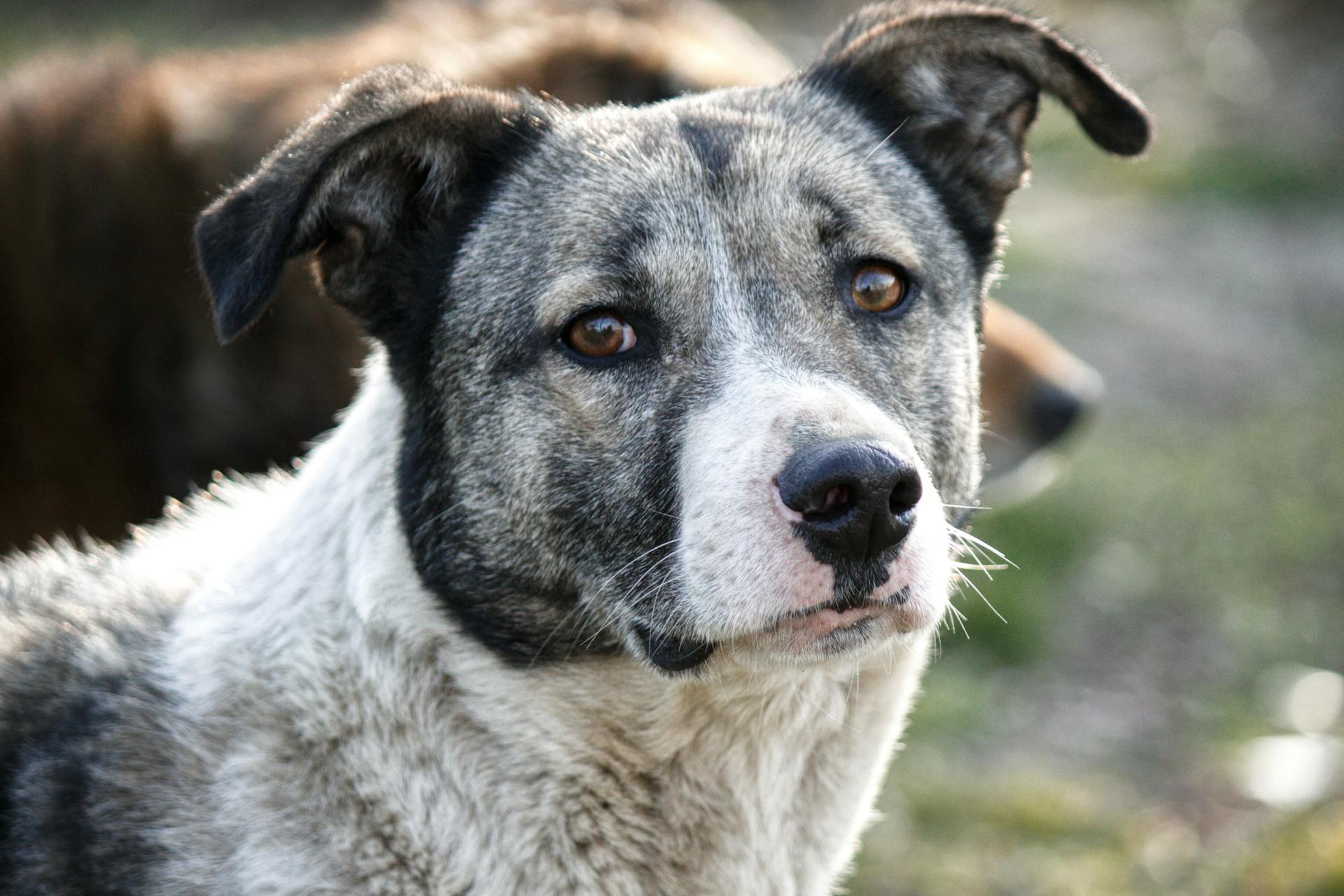
Australian Cattle Dogs, also known as Blue Heelers, are bred to be working dogs, so they need plenty of exercise to stay happy and healthy.
Exercise is crucial for these energetic dogs, and they require more than just an evening walk or a quick game of fetch. Plan to spend at least one to two hours a day engaging your Blue Heeler in physical activity.
These dogs are built for speed and agility, and they can reach nearly 30 mph at full sprint, making them perfect for active families or individuals with a love for outdoor activities.
Daily walks or jogs are essential for Blue Heelers, and they also love participating in dog sports and agility training.
Curious to learn more? Check out: How Much Exercise Does a Blue Heeler Need
Family and Pet Compatibility
Blue Heelers are excellent family companions, especially if they're raised with children from an early age. They're very playful and protective, but they need to be socialized to children to prevent nipping and biting.
They may want to herd kids with sharp nips, or bite when youngsters play too roughly, so it's essential to teach children how to approach and touch dogs, and always supervise interactions between dogs and young children.
With proper training, Blue Heelers can seamlessly integrate into households, particularly those with children. They're not prone to aggression and can be gentle, but early training may be required to address nipping tendencies.
If you're introducing a Blue Heeler to a household with other pets, such as cats or small animals, it's crucial to socialize them early on. If they're raised with a cat or other animal from puppyhood, they'll likely consider it a member of the household and leave it alone.
However, if they're not socialized, they may chase, catch, and even kill small animals, so it's essential to supervise interactions and teach them to respect other pets.
If this caught your attention, see: Why Are Labradors so Friendly
Health and Energy
Blue Heelers are notorious for their boundless energy, which can be a challenge for owners who don't have a lot of time to devote to exercise.
They need at least 2 hours of exercise a day to stay happy and healthy.
If you don't have a big yard, you'll need to get creative with your exercise routine, such as taking them on long walks or hikes.
Leash-free running is a must for this breed, as it allows them to burn off energy and stretch their legs.
Blue Heelers don't like to be left alone for long periods, especially in small spaces, so it's best to bring them along on outings.
With the right amount of exercise and attention, Blue Heelers can thrive in a variety of living situations, from small apartments to large farms.
Related reading: Are Blue Heelers Double Coated
Pros and Cons
The blue heeler temperament is a unique blend of loyalty, energy, and independence. They are a working dog breed that thrives on physical and mental stimulation.
One of the biggest pros of blue heelers is their loyalty to their family. They are known to form strong bonds with their owners and are often described as "velcro dogs" because of their tendency to stick close by.
Blue heelers are also highly intelligent and trainable, making them a great fit for active families who enjoy outdoor activities. They excel in dog sports and can learn a wide range of commands and tasks.
However, blue heelers are not the right fit for every family. They require regular exercise and mental stimulation to prevent boredom and destructive behavior.
Blue heelers are a high-energy breed that needs plenty of physical activity to stay happy and healthy. A daily walk or run is just the beginning - they also need time to play and engage in activities that challenge their minds.
Despite their high energy levels, blue heelers are generally quiet dogs that don't bark much. They are more likely to express themselves through body language and vocalizations, so it's essential to learn their non-verbal cues.
Explore further: Blue Heeler Energy Level
Appearance
An Australian cattle dog's appearance is a sight to behold, with oval brown eyes that sparkle with attention. His intent, curious expression is infectious and can't help but make you wonder what's next.
His head is curved and broad, with a short and sharp muzzle, and a slightly bushed tail hangs loosely off his hindquarters. The combination of these features gives him a unique and striking appearance.
An ACD's body is lean and athletic, reflecting the coiled energy resting beneath his double coat. His evenly proportioned, solid frame supports power and endurance, standing about 19 inches tall at the withers.
His outer coat is short and bristly, while the soft undercoat provides insulation from temperature extremes. This unique coat combination helps him thrive in a variety of environments.
No two Australian cattle dog coats are ever quite the same, but one consistent element on many cattle dogs is a contrasting color patch over one or both eyes that differs from the muzzle hue.
Related reading: Australian Cattle Blue Heeler Mix
History
The Australian Cattle Dog, also known as the Blue Heeler, has a rich and diverse history that spans centuries.
Bred by 19th-century Australian settlers to herd cattle on large ranches, this breed was instrumental in helping ranchers expand the Australian beef industry.
A unique perspective: Blue Heeler vs Australian Cattle Dog
The breed's ancestors include the native Dingo, which was crossed with the Scottish Highland Collie and the Dalmatian to create the robust and intelligent dog we know today.
Ranchers sought a hardy dog who could handle the harsh climate and working conditions in Australia, and after many breedings and cross-breedings, they finally developed a breed that could thrive in this environment.
In 1893, Robert Kaleski took up breeding Blue Heelers, and he started showing them in 1897, drawing up a standard based on the Dingo, which he believed was the type naturally suited to the Australian outback.
The Kennel Club of New South Wales approved this standard in 1903, and the breed was first known as the Australian Heeler, then later as the Australian Cattle Dog.
In May 1980, the Australian Cattle Dog was accepted for registration by the American Kennel Club, and it became eligible for show in the Working Group in September of that year.
After a period in the Miscellaneous Class, the breed was transferred to the Herding Group in January 1983.
The breed was first brought to America in 1950, and it was admitted to the American Kennel Club in 1980, becoming a charter member of the AKC Herding Group at its inception.
Today, the Australian Cattle Dog is a popular breed, known for its intelligence, loyalty, and herding ability, and it's considered a great companion for active families and individuals.
Curious to learn more? Check out: Standard Blue Heeler
Frequently Asked Questions
Why is my Blue Heeler so aggressive?
Your Blue Heeler's aggression may be due to its inherited instinct to protect territory and strangers, a trait developed from its original purpose as a working dog. Understanding its breed history and instincts can help you address this behavior and find ways to train a more balanced temperament.
What are Queensland heelers known for?
Queensland Heelers are known for their intelligence and resilience, often outsmarting their owners. They are a compact but muscular breed with a strong herding instinct.
Do Queensland heelers bark a lot?
Queensland Heelers, also known as Australian Cattle Dogs, are prone to excessive barking due to their alert nature, making them a high-maintenance breed for owners
What is the demeanor of a Queensland heeler?
Queensland heelers are known for their friendly, loyal, and playful nature, making them devoted companions. With proper training, they can thrive as loving and energetic family pets
Are Australian heelers good pets?
Australian Heelers make great family pets due to their friendly nature, making them a solid addition to many homes. They can thrive as pets in a variety of settings, far from their traditional rural roots.
Sources
Featured Images: pexels.com
